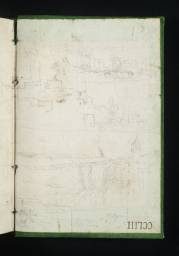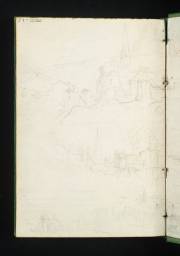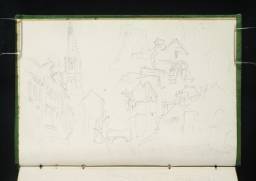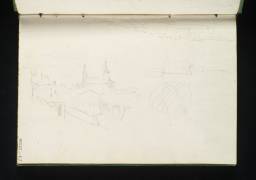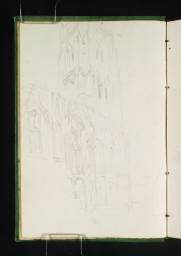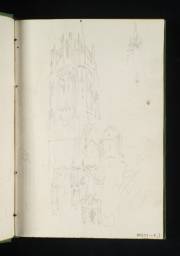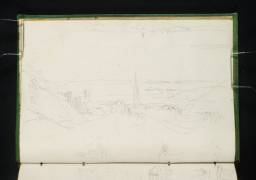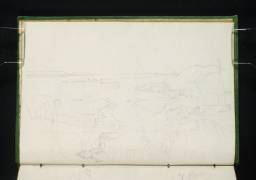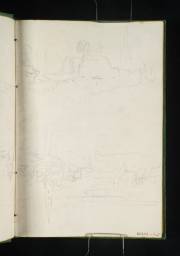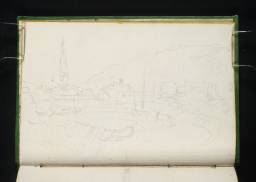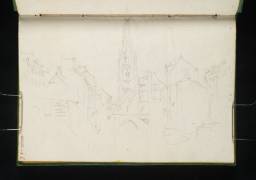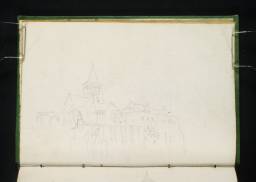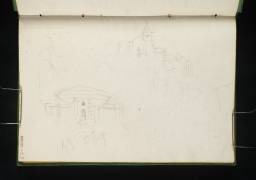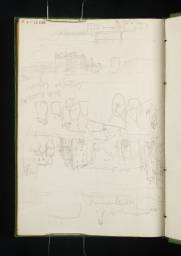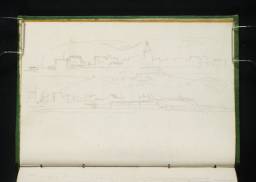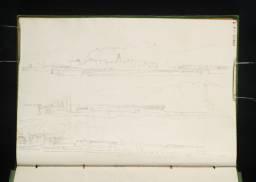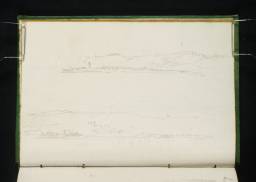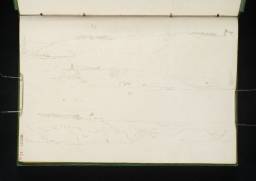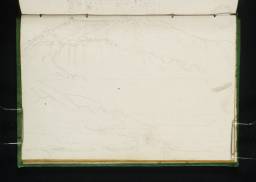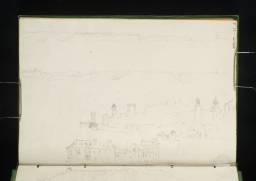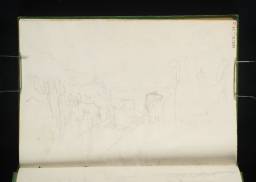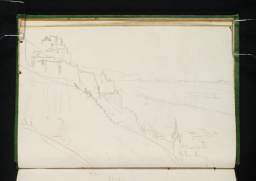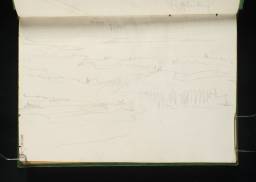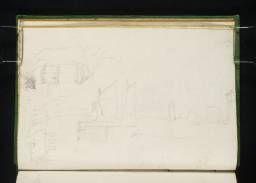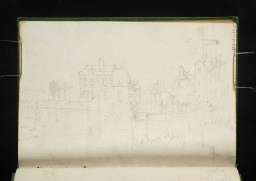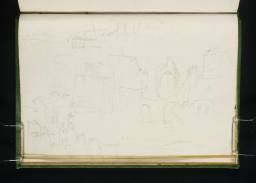Turner Bequest CCLIII 1–94a
Sketchbook bound in green parchment with marks on the fore-edge of the front and back covers suggesting that it once had a clasp
94 leaves of pale cream laid paper, no watermark, with edges washed in yellow; approximate page size 156 x 107 mm
Stamped in black ‘CCLIII’ top right corner of front cover
Inscribed in pencil ‘CCLIII’ bottom right of back cover, upside down
Stamped in black ‘CCLIII’ top left inside front cover (D14080)
Numbered 363 as part of the Turner Schedule in 1854 and endorsed by the Executors of the Turner Bequest inside back cover (D14081)
94 leaves of pale cream laid paper, no watermark, with edges washed in yellow; approximate page size 156 x 107 mm
Stamped in black ‘CCLIII’ top right corner of front cover
Inscribed in pencil ‘CCLIII’ bottom right of back cover, upside down
Stamped in black ‘CCLIII’ top left inside front cover (D14080)
Numbered 363 as part of the Turner Schedule in 1854 and endorsed by the Executors of the Turner Bequest inside back cover (D14081)
Accepted by the nation as part of the Turner Bequest 1856
Exhibition history
References
This sketchbook records Turner’s impressions on a tour of Normandy, in northern France. In his 1909 Turner Bequest Inventory, A.J. Finberg recorded the wording of Turner’s label on the spine (since lost) as ‘Tankerville [sic, i.e. Tancarville], Lillebonne’,1 in reference to two of the towns he visited on the tour.
The tour and sketchbook appear to date from 1829. A summary of the research leading to this conclusion is as follows. Originally estimated by Finberg to date from around 1830,2 art historian Gerald Wilkinson also noted the sketchbook as dating from 1830,3 whilst art historians Gerald Finley and Andrew Wilton suggested this sketchbook probably related to Turner’s trip to France of 1832.4 However, the majority of research points to a date of 1829. Having initially estimated 1830 in the published inventory, in a manuscript annotation to the Inventory which he ascribes to ‘JPH’ (indicating the artist and collector John Postle Heseltine, 1843–1929), Finberg later suggested 1829.5 In addition Wilton, and fellow art historians Martin Butlin and John Gage, refer to this sketchbook as dated by Finberg to about 1830 but in use a few years earlier.6
Art historian Cecilia Powell listed Turner’s known tours and included a tour of Paris and the Seine in 1829.7 Art historian Ian Warrell stated of Turner that ‘During the 1820s he travelled along the Seine regularly, either on his way southwards, or purely because of his interest in the river as a source of potential subject matter (specifically in 1821, 1826, 1828, 1829, and 1832).’8 Wilton also put forward that this sketchbook probably related to a French tour in September 1829.9 He further stated that ‘Turner sketched extensively along the estuary of the Seine on his way back from Rome in 1829’, and the sketchbook (as well as the Seine and Paris sketchbook; Tate; Turner Bequest CCLIV, since dated to 1832) was used in that area;10 however, as discussed below it now seems unlikely that the present sketches were made on the actual return journey from Rome, but instead later that same year.
Art historian Nicholas Alfrey also proposed that Turner travelled the length of the River Seine from Le Havre to Paris at the end of summer 1829 and that this sketchbook was likely to relate to that tour.11 Alfrey referred to Finberg for confirmation of Turner’s presence in France in 1829.12 Warrell referred to Turner seeming to have made the sketches of Poissy in 1829 whilst pausing briefly on his way to Paris. Art historian Martin F. Krause stated that the sketchbook recorded ‘Turner’s passage through Rouen in the late 1820s’ and from sketches which seem to show the rebuilding of Rouen cathedral spire in 1827, dated the sketchbook to this date or soon thereafter.13 Turner is known from his correspondence to have been in Paris in August of both 1828 and 1829,14 and Krause disregarded Turner’s French tour of 1832 as being for a different mission.15 Warrell also tied the sketchbook to a guidebook dating from 1829, M.J. Morlent’s Voyage Historique et Pittoresque du Havre à Rouen sur la Seine, en Bateau à Vapeur (third edition), as it contains annotations by Turner made with the same blunt pencil as in this sketchbook.16
Turner’s correspondence points to more specific dating. His letter to the painter, scholar and art-administrator C.L. Eastlake, dated 11 August 1829,17 indicates Turner was in London on this date, and is followed by a letter from him to the sculptor and illustrator, Francis Legatt Chantrey, dated 9 September 1829 in which Turner writes ‘I have at last returned from France...’.18 The Normandy tour would therefore have taken place sometime in these four weeks between 11 August and 9 September. Finberg noted that the engraver Robert Wallis’s first proof of one of Turner’s prints was sent to the artist in Paris and arrived there on 21 August, after which Turner worked on it and posted it back,19 which indicates he must have been in Paris sometime between 21 August and early September. Finberg suggested that after returning the engraving Turner then made his way down the Seine to Honfleur, and into Normandy (as well as round Cotentin-Cherbourg to Guernsey,20 though this latter suggestion has now been discredited21). However, because the sequence of sketches in the sketchbook clearly records travelling eastwards from Harfleur towards Paris, it seems likely that Turner undertook the tour before arriving in Paris, not after, and the tour therefore took place between 11 August and sometime after 21 August 1829.
In 1829, Turner had spent the beginning of the year in Italy, and travelled back from Rome to be in London in February. He remained there for the Royal Academy exhibition, before setting off again in August, it seems from his correspondence written throughout the summer with the intention originally of returning to Rome.22 However, he remained in France. A possible reason for such change of plans and the undertaking of a shorter trip to France rather than continuing on to Italy may have been the ill health of Turner’s father, who later passed away that year on 21 September.
Turner’s Normandy itinerary, revealed by the sketchbook, consisted of essentially travelling consistently upriver eastwards from the Seine estuary towards Paris. The sketchbook begins at Harfleur (then incongruously moves to a view of Poissy which is located some 106 miles or 170 kilometres from Harfleur), returns to Harfleur, and then proceeds (albeit with earlier subjects recurring somewhat unsystematically among the later ones) through Le Havre, Graville, Honfleur, Tancarville, Le Havre (Sainte-Adresse), Lillebonne, Quillebeuf, Villequier, Mailleraye, Jumièges, Duclair, Canteleu, Rouen, Igoville, Pont de l’Arche, to Poissy (approximately 19 miles or 30 kilometres westwards of Paris). Interestingly, as Warrell points out, there are no sketches from the route between the two final destinations, Pont de l’Arche and Poissy, a distance of approximately 60 miles or 100 kilometres. This could indicate that Turner may have had insufficient time and have been rushing to return to Paris; or as Warrell also suggests, he may have been prevented from sketching by particularly rainy weather as indicated in records for August that year.23
The views depicted in the sketches range from street scenes and details of buildings, such as the Church of Saint-Martin in Harfleur, the Lieutenancy building in Honfleur (for example, folio 15 recto; D23726), and the Church of Notre-Dame in Lillebonne; to landscape views looking over towns such as Harfleur with the river Seine in the distance; to quayside views of towns such as Harfleur and Le Havre; to coastal views of Le Havre; to successive views over castles such as Lillebonne and Tancarville (for example, folio 37 recto; D23770), as well as other ruins such as the Roman amphitheatre at Lillebonne, and natural geological structures such as the Chaire de Gargantua near Duclair; and to views of vessels on the river and riverside scenes.
In general, the sketches are not detailed. Yet Turner’s skill can capture a scene evocatively in a few lines; as an example, see folio 41 recto (D23778). Some of the sketches are very rough, for example folio 83 recto (D23862) and their quick, continuous pencil lines indicate they were made whilst Turner was moving, perhaps depicting views as seen from the window when travelling by carriage. Others, such as folio 2 verso (D23702) of the Church of Saint-Martin, Harfleur pick out architectural features in some detail whereas yet others of architectural structures such as the old bridge at Poissy (from folio 86 verso, D23868, onwards) do not concentrate on such structural elements.
The area covered by the sketchbook in general was familiar to Turner. Not only had he travelled along the Seine in 1821 and 1826,24 as Warrell states Turner had previously specifically sketched the area from Rouen to Le Havre including Harfleur, Lillebonne and Honfleur on the tour of 1826.25 Warrell also notes that Turner visited Le Havre on at least four occasions between 1821 and 1832,26 and confirms of Turner, in reference to the Seine and Paris sketchbook from the tour of 1832, ‘As he had many times before, he noted the familiar landmarks along the route: Honfleur, Tancarville, Quillebeuf, Lillebonne, Caudebec, Chateau de la Mailleraye, ... Jumièges, Duclair, ... Rouen.’27
John Ruskin’s endorsement of the sketchbook on a lost wrapper read: ‘263. French. Of considerable interest, but too hard pencil.’28
Technical notes
How to cite
Caroline South, ‘Tancarville and Lillebonne Sketchbook ?1829’, sketchbook, May 2017, in David Blayney Brown (ed.), J.M.W. Turner: Sketchbooks, Drawings and Watercolours, Tate Research Publication, November 2019, https://www

